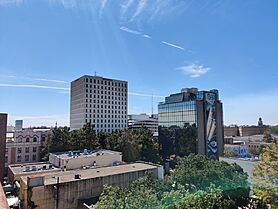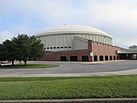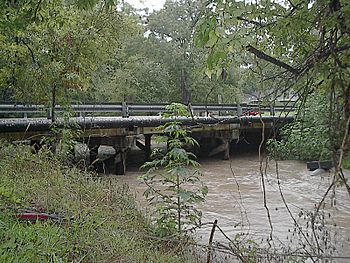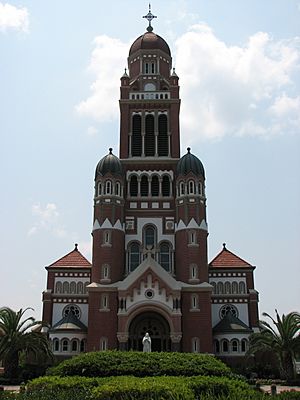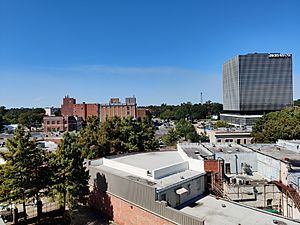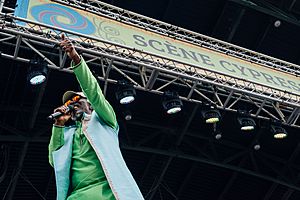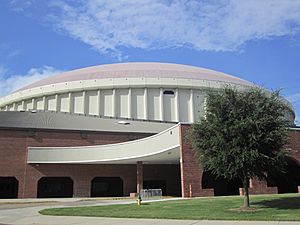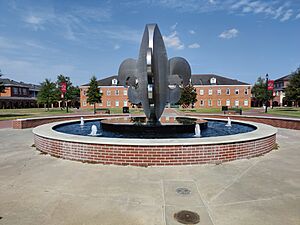Lafayette, Louisiana facts for kids
Quick facts for kids
Lafayette, Louisiana
|
|||||
|---|---|---|---|---|---|
|
Consolidated city-parish
|
|||||
|
Downtown
St. John the Evangelist's Cathedral
Charles H. Mouton House
Old Lafayette City Hall
Cajundome
First United Methodist Church
|
|||||
|
|||||
| Nickname(s):
The Hub City
|
|||||
| Motto(s):
The Heart of Cajun Country
|
|||||
| Country | United States | ||||
| State | Louisiana | ||||
| Parish | Lafayette | ||||
| Founded | 1821 as Vermilionville | ||||
| Renamed | 1884 as Lafayette | ||||
| Founded by | Jean Mouton | ||||
| Named for | General Gilbert du Motier, Marquis de Lafayette | ||||
| Government | |||||
| • Type | Consolidated city–parish | ||||
| Area | |||||
| • Total | 56.00 sq mi (145.03 km2) | ||||
| • Land | 55.92 sq mi (144.83 km2) | ||||
| • Water | 0.08 sq mi (0.20 km2) auto% | ||||
| • Metro | 3,408.5 sq mi (8,828 km2) | ||||
| Elevation | 49 ft (15 m) | ||||
| Population
(2020)
|
|||||
| • Total | 121,374 | ||||
| • Rank | US: 234th | ||||
| • Density | 2,170.57/sq mi (838.07/km2) | ||||
| • Urban | 227,316 (US: 172nd) | ||||
| • Urban density | 1,410.1/sq mi (544.4/km2) | ||||
| • Metro | 478,384 (US: 118th) | ||||
| • CSA | 627,146 (US: 77th) | ||||
| • Consolidated | 244,390 | ||||
| Demonym(s) | Lafayettien | ||||
| Time zone | UTC−6 (CST) | ||||
| • Summer (DST) | UTC−5 (CDT) | ||||
| ZIP codes |
70501–9, 70593, 70596, 70598
|
||||
| Area code(s) | 337 | ||||
| FIPS code | 22-40735 | ||||
Lafayette (/ˌlæfiˈɛt, ˌlɑːf-/ LA(H)-f-EE-et, French: [lafajɛt]) is the most populous city in and parish seat of Lafayette Parish in the U.S. state of Louisiana, located along the Vermilion River. It is Louisiana's fourth-most populous city with a 2020 census population of 121,374; the consolidated city-parish's population was 241,753 in 2020. The Lafayette metropolitan area was Louisiana's third largest metropolitan statistical area with a population of 478,384 at the 2020 census. The Acadiana region containing Lafayette is the largest population and economic corridor between Houston, Texas and New Orleans.
Originally established as Vermilionville in the 1820s and incorporated in 1836, Lafayette developed as an agricultural community until the introduction of retail and entertainment centers, and the discovery of oil in the area in the 1940s. Since the discovery of oil, the city and parish have had the highest number of workers in the oil and natural gas industry in Louisiana as of 2018. With the issuance of a bond ordinance for a series of roads connecting nearby settlements; the establishment of the University of Louisiana System's Lafayette campus; and the continued diversification of its economy, Lafayette and its metropolitan area have experienced population growth since the 1840 census and was promptly nicknamed "The Hub City." The city and parish of Lafayette are also known as the "Heart of Acadiana."
As a result of its growth, the city and region have become major centers for the technology industry; Lafayette also became a major center for health care and social services, aerospace, banking and retail. Notable corporations with headquarters or a large presence in the Lafayette area have included Amazon, Brookshire Grocery Company, CGI, JP Morgan Chase, Ochsner Health System, Petroleum Helicopters International, and Rouses Markets.
Lafayette is home to a diverse population from Louisiana Creole and Cajun backgrounds. In 2014, Lafayette was named the "Happiest City in America.” The city and region's cultural icons include Alexandre Mouton House, Brandt House, Charles H. Mouton House, the Cathedral of Saint John the Evangelist, Daigle House, First United Methodist Church, Holy Rosary Institute, Hope Lodge No. 145, and Old Lafayette City Hall. Its educational institutions include the University of Louisiana at Lafayette, South Louisiana Community College, and Remington College.
Contents
Etymology
Lafayette is named after Marquis de Lafayette. Little is known about early settlements or if the area had a different name prior to European colonization. The city was originally founded in 1821 as Vermilionville.
History
Geography
Lafayette is located at 30°13′N 92°2′W / 30.217°N 92.033°W (30.2139, -92.0294) and has an elevation of 36 feet (11.0 m). According to the United States Census Bureau, the city has a total area of 49.2 square miles (127 km2), of which 49.1 square miles (127 km2) is land and 0.1 square miles (0.26 km2) (0.19%) is water.
Lafayette is located on the West Gulf Coastal Plain. What is now Lafayette was part of the seabed during the earlier Quaternary Period. During this time, the Mississippi River cut a 325-foot-deep (99 m) valley between what is now Lafayette and Baton Rouge. This valley was filled and is now the Atchafalaya Basin. Lafayette is located on the western rim of this valley.
This land, called the southwestern Louisiana Prairie Terrace, is higher up and not made of wetland like much of the surrounding areas to the south and west of Lafayette. Because of this, Lafayette does not suffer significant flooding problems, outside of local flash flooding, or other high water levels which prevent the Vermilion River or other waterways from their usual southward flow. The Vermilion River runs through the center of Lafayette. Other significant waterways in the city are Isaac Verot Coulee, Coulee Mine, Coulee des Poches and Coulee Ile des Cannes, which are natural drainage canals that lead to the Vermilion River.
Image gallery
Demographics
| Historical population | |||
|---|---|---|---|
| Census | Pop. | %± | |
| 1860 | 498 | — | |
| 1870 | 777 | 56.0% | |
| 1880 | 815 | 4.9% | |
| 1890 | 2,106 | 158.4% | |
| 1900 | 3,314 | 57.4% | |
| 1910 | 6,392 | 92.9% | |
| 1920 | 7,855 | 22.9% | |
| 1930 | 14,635 | 86.3% | |
| 1940 | 19,210 | 31.3% | |
| 1950 | 33,541 | 74.6% | |
| 1960 | 40,400 | 20.4% | |
| 1970 | 68,908 | 70.6% | |
| 1980 | 80,584 | 16.9% | |
| 1990 | 94,440 | 17.2% | |
| 2000 | 110,257 | 16.7% | |
| 2010 | 120,623 | 9.4% | |
| 2020 | 121,374 | 0.6% | |
| U.S. Decennial Census | |||
| Race / Ethnicity (NH = Non-Hispanic) | Pop 2000 | Pop 2010 | Pop 2020 | % 2000 | % 2010 | % 2020 |
|---|---|---|---|---|---|---|
| White alone (NH) | 74,020 | 74,424 | 69,117 | 67.13% | 61.70% | 56.95% |
| Black or African American alone (NH) | 31,292 | 37,255 | 37,025 | 28.38% | 30.89% | 30.50% |
| Native American or Alaska Native alone (NH) | 250 | 350 | 344 | 0.23% | 0.29% | 0.28% |
| Asian alone (NH) | 1,573 | 2,162 | 3,136 | 1.43% | 1.79% | 2.58% |
| Pacific Islander alone (NH) | 24 | 29 | 33 | 0.02% | 0.02% | 0.03% |
| Some Other Race alone (NH) | 135 | 227 | 457 | 0.12% | 0.19% | 0.38% |
| Mixed Race or Multi-Racial (NH) | 892 | 1,645 | 3,731 | 0.81% | 1.36% | 3.07% |
| Hispanic or Latino (any race) | 2,071 | 4,531 | 7,531 | 1.88% | 3.76% | 6.20% |
| Total | 110,257 | 120,623 | 121,374 | 100.00% | 100.00% | 100.00% |
Attakapa Native Americans were originally the primary residents of the Lafayette area before French colonization, concentrated along the Vermilion River. After the Louisiana Purchase, American settlers began moving into the area and intermarrying among the French, enslaved Africans, and free people of color. Since 1860, Lafayette has grown from 498 to 121,374 residents at the 2020 U.S. census. Following the American Community Survey's 5 year estimates program, the city has continued population growth with an additional 2020 estimate at 126,674 residents.
With the migration and population growth of European, African, and multiracial Americans since early settlement, the racial and ethnic makeup of the city has been predominantly non-Hispanic or Latino white, Black or African American, multiracial, and Asian. French, German, English, American, Irish, and Italian were the largest European ancestry groups among the non-Hispanic or Latino white population. Asian settlers arrived during the establishment of Filipino communities along the coast of Louisiana (primarily in the Greater New Orleans area) up to established communities in the Acadiana region as of 2013. The city and area's Hispanic and Latino American population have existed since Spanish colonization of Louisiana.
According to 2021 estimates from the U.S. Census Bureau, its non-Hispanic or Latino white population have been prevalent throughout the city proper's geographic foothold with exception to its northern neighborhoods. More than 34% of its Hispanic and Latino American population lived in the central-west portion of the city, and Black and African Americans primarily dominated the northern half of Lafayette city proper. Its Asian American community was dispersed throughout the whole city alongside multiracial Americans, and people of other races and ethnicities primarily lived near downtown or the city's border with Carencro.
Having historic growth from the 20th and 21st centuries attributed primarily to the oil and gas industry, the University of Louisiana at Lafayette, and Acadiana tourism, an estimated 3.8 percent of the city's population was foreign-born from 2014 to 2019; of the foreign-born population, 33.6 percent were naturalized U.S. citizens. Altogether English, French, and Spanish were the most spoken languages at home among the native and foreign-born populations. In 2022, the city's foreign-born population grew to 5.8%.
Poverty remaining an issue in the city with an estimated 18.6 percent at or below the national poverty threshold in 2019, the median income for a family was $54,139 in 2020 and Lafayettiens had a mean household income of $79,216; among non-family households, the median income stood at $34,588. The city had an employment rate of 60.4 percent, up from the state's 55.4 percent from 2014 to 2019.
Religion
In common with Louisiana's religious demographic as part of the Bible Belt, Lafayette and its metropolitan area are predominantly religious, dominated by Christianity. As of 2020 according to Sperling's BestPlaces, the Catholic Church was the single largest Christian denomination, and Protestants were the largest collective Christian group. Among Protestant Christians, Evangelical Protestantism was the largest transdenominational body and historically Black or African American churches were the second largest. Mainline Protestantism remained a minority, mainly supported by the Episcopal Church in the United States and its Diocese of Western Louisiana.
Owing in part to Spanish and French colonialism and missionary work, Christians have historically affiliated with the Latin Church's Roman Catholic Diocese of Lafayette in Louisiana. The Roman Catholic Diocese of Lafayette in Louisiana was founded in 1918 and its see is the Cathedral of Saint John the Evangelist. Within the local Protestant traditions, Baptists were the second largest individual Christian denomination, and the most historically prominent Evangelical Baptist denomination has been the Southern Baptist Convention. The National Baptist Convention, USA, Inc. and National Baptist Convention of America have been the city and region's historically Black or African American Baptist denominations.
Pentecostals, making up the third largest Christian community in Lafayette, have been primarily served by the Church of God in Christ and Assemblies of God USA. Methodists, Mormons, Lutherans, and Presbyterians formed the remaining Christian population of Lafayette and its metropolitan area. Christians of other faiths including the Jehovah's Witnesses and united and uniting churches have been present in the city's metropolitan area since the 20th century. The Church of Jesus Christ of Latter-day Saints is the oldest nontrinitarian Christian denomination in Lafayette, and has one church in the city limits; the closest LDS churches outside of Lafayette are in New Iberia and Opelousas. Within the "other Christian" dynamic, there has been one Antiochian Orthodox jurisdiction operating since 2004; there is also a Coptic Orthodox mission under the Coptic Orthodox Diocese of the Southern United States. Altogether, the Eastern Orthodox Church, Oriental Orthodox Churches, and non-mainstream Protestantism have constituted a significant minority.
Judaism and Islam were tied as the second largest non-Christian religions within Lafayette and its metropolitan area. Jews began immigrating to the area in the 1800s, and one of Louisiana's oldest continuously-operated synagogues (Temple Shalom) has been present in the city since 1869. The historic synagogue of Temple Shalom originally functioned as an Orthodox Jewish congregation before joining the Reform Judaism movement. Lafayette's Jewish community has assisted in economic and cultural development of the area since their arrival.
Economy
Established and occupied as an agricultural community until the 1940s, Lafayette became a center of the oil and natural gas industry in Louisiana. In addition, the city and its metropolitan area became major centers for technology, health care and social services, aerospace, banking and retail from the latter 20th- and early 21st centuries.
As of 2021, the consolidated city–parish's top employers have been the Lafayette Parish School System, Lafayette General Health, Wood Group Production Services, Lafayette Consolidated Government, the University of Louisiana at Lafayette, WHC, Inc., Walmart, Our Lady of Lourdes Regional Medical Center, Schlumberger, and Stuller, Inc. The University of Louisiana System's other institutions and its Lafayette campus have contributed to a $10.9 billion impact on the state's economy. As one of the primary employers in Lafayette, the local university has made a statewide impact of $379 million in 2015.
Prominent corporations with headquarters or a large presence in Lafayette have included or currently include Albertsons, Amazon, Brookshire Grocery Company, CGI, First Horizon Bank, JP Morgan Chase, LUSFiber, the Ochsner Health System, Petroleum Helicopters International, Perficient, and Rouses Markets. Among these corporations, the Tennessee-based First Horizon Bank absorbed IberiaBank (a former Louisiana-based banking institution) in 2020. Other notable corporations stimulating the city and metropolitan economies have been Lowe's, Costco, and various national retail and department stores in the Mall of Acadiana. By December 2023, Topgolf opened a venue in Lafayette.
Ranking as one of the best places to retire in Louisiana according to Forbes in 2018, Lafayette was also ranked one of the best places for businesses and careers in 2019; according to Forbes, it was #25 in the cost of doing business, #200 in job growth, and #175 in education nationwide. Per U.S. News & World Report, its cost of living has contributed to it being ranked as the second best place to live in Louisiana.
Culture
Located in Acadiana, Lafayette is a diverse city with a large and growing metropolitan population as of 2015. The Lafayette metropolitan area has a large Louisiana Creole, Cajun, and substantial foreign-born population; an estimated 14,676 Lafayettiens were foreign-born residents in 2019. Additionally, more than 36% of foreigners came from Asia from 2014 to 2019.
Many annual events celebrate the diverse cultures of Lafayette. Notable cultural gatherings have included the Festivals Acadiens et Créoles, Festival International de Louisiane, Boudin Cookoff and Bacon Fest, the Cajun Heartland State Fair, and Le Festival de Mardi Gras à Lafayette. Residents also celebrate their cultural identities through visiting Acadian Village or Vermilionville Historic Village. Highly regarded for its diverse food and restaurant culture, Lafayette has been regarded as having the fourth-most restaurants per capita in Louisiana since 2015.
Home to the Acadiana Symphony Orchestra and Conservatory of Music, Chorale Acadienne, Lafayette Ballet Theatre and Dance Conservatory, the Lafayette Concert Band, and Performing Arts Society of Acadiana; as well as the Paul and Lulu Hilliard University Art Museum, Acadiana Center for the Arts and Heymann Performing Arts Center, Lafayette has hosted Tyler Perry's Madea's Farewell play in 2019. The 2018 television film, The Christmas Contract, set in Lafayette, features many Cajun Christmas customs. Lafayette is also home for the only two Cajun themed restaurants named Prejeans. (Located in Carencro and Broussard.)
Sports
Lafayette is home to the Louisiana Ragin' Cajuns, the athletic teams of the University of Louisiana at Lafayette. Between 1995 and 2005, Lafayette was home to the Louisiana IceGators ECHL hockey team. In 2009, the IceGators returned as a member of the Southern Professional Hockey League until 2016. Also from 2009 to 2012, Lafayette was home to the Lafayette Wildcatters of the Southern Indoor Football League. It also became home to the Lafayette Bayou Bulls, a semipro football program started in 2003. The Lafayette SwampCats (1997–1999) and Lafayette Swamp Cats (2000–2004) soccer teams played in the city. The Cajun Soccer Club of the Gulf Coast Premier League was founded in 2013; Louisiana Krewe FC played in the Gulf Coast Premier League before joining USL League Two for its 2022 season.
The Lafayette area is home to multiple sports venues: Blackham Coliseum, Cajundome, Cajun Field (now Our Lady of Lourdes Stadium), Earl K. Long Gymnasium, Evangeline Downs, and Planet Ice Skating and Hockey Arena.
Lafayette was home to minor-league baseball teams in various seasons from 1907 to 2000. Lafayette was an affiliate of the St. Louis Browns 1936–1941, Chicago Cubs (1955–1957) and San Francisco Giants (1975–1976). The Lafayette Browns (1907), Lafayette Hubs (1920), Lafayette White Sox (1934–1942), Lafayette Bulls (1948–1953), Lafayette Oilers (1954–1957), Lafayette Drillers (1975–1976) and Bayou Bullfrogs (1998–2000) all played in Lafayette. The teams were members of the Gulf Coast League (1907), Louisiana State League (1920), Evangeline League (1934–1942, 1948–1957), Texas League (1975–1976) and Texas-Louisiana League (1998–2000). Lafayette teams played at Parkdale Park (1934–1942), Clark Field (1945–1957, 1975–1976) and Tigue Moore Field (1998–2000).
In addition, the sport of trampoline developed in Lafayette. Jeff Hennessy's gymnastics program at the University of Louisiana at Lafayette popularized the sport and produced more world champions — including his daughter, Leigh Hennessy — than any other location. Jeff Hennessy was also instrumental in getting trampoline into the Olympic Games, and several athletes from Trampoline & Tumbling Express in Lafayette have represented the United States at the Olympics.
Media
Lafayette's major daily newspaper is The Daily Advertiser, owned by Gannett (publishers of USA Today). Established in 1865 as the Weekly Advertiser, it purchased the local alternative paper, The Times of Acadiana in 1998. Other prominent newspapers in the Lafayette area include Acadiana Profile, Baton Rouge-based The Advocate and its local paper The Acadiana Advocate, The Independent, and UL-based The Vermilion. The Current is a non-profit online news organization that has published since 2017.
Licensing more than 22 FM and AM radio stations in its metropolitan area, Lafayette includes Valcour Records and ML1 Records in its metropolis. Major television stations include KATC 3 (ABC), KLFY-TV (CBS), KLAF-LD (NBC), KADN-TV (Fox), and KLPB-TV (PBS). Other major stations serving the Lafayette area include Alexandria's KALB-TV (CBS and NBC), Baton Rouge's WBRZ (ABC), WAFB (CBS), WGMB-TV (Fox), WVLA-TV (NBC), and Lake Charles' KPLC-TV (NBC). According to Nielsen Media Research, the Lafayette television market was the 123rd largest in the United States as of 2019.
Education
Primary and secondary education
Lafayette Parish School System is the largest primary and secondary education system for Lafayette and its metropolitan area. Covering the whole of Lafayette Parish, it has 45 schools: 25 elementary schools, 12 middle schools, and eight high schools. The Lafayette Parish School System offers nine career academies at the high-school level, school curricula designed to prepare students in certain career fields. Of note among the schools in this system are Lafayette High School and Acadiana High School, its two largest high schools by enrollment.
A majority of the area's private parochial, K-12 schools are operated by the Roman Catholic Diocese of Lafayette in Louisiana.
Collegiate and university education
Its university, the University of Louisiana at Lafayette, is the flagship university for the University of Louisiana System; as a national research institution and home to more than 18,000 students, over 100 programs, and the Louisiana Ragin' Cajuns, it is the second-largest university in the state behind Louisiana State University in Baton Rouge. Attempting unsuccessfully to change its name to the "University of Louisiana" previously, the university's moniker as "Louisiana" became points of contention, and the community colloquially refers to the institution as the University of Louisiana, dropping "Lafayette" from the name.
One of the newest college systems in Louisiana, South Louisiana Community College, is headquartered in Lafayette. South Louisiana Community College partnered with Acadian Ambulance to form the National EMS Academy, which offers EMT-Basic and EMT-Paramedic certification. This community college is part of the Louisiana Community and Technical College System. Louisiana Technical College (Lafayette campus) is part of the Louisiana Technical College System, which in turn is part of the Louisiana Community and Technical College System. It offers associate degrees in several fields. It is a vocational school that offers a few bachelor's-degree programs, many associate-degree programs, and a few diploma programs. Additionally, Lafayette is also home to the Lafayette campus of the Academy of Interactive Entertainment, a technical college that specializes in video game programming, art and animation, and SFX.
Military
Lafayette is home to the Louisiana Army National Guard headquarters of the 256th Infantry Brigade, a military unit of more than 3,000 soldiers. The unit served in Iraq in 2004–2005. The brigade was deployed again in January 2010. Until 2014, Lafayette was also home to the United States Marine Corps Reserve Unit, F. Co. Anti-Terrorism Battalion commanded by Captain Cole Clements. This unit went on several deployments, many related to the Iraq War. In 2014, F. Co. Anti-Terrorism Battalion was decommissioned, to be replaced with H&S Co. Det. 4 4th Tanks Tow and Scouts, 4th MARDIV.
Transportation
Lafayette Regional Airport—located on U.S. Highway 90 (future Interstate 49), on the southeast side of the city with daily scheduled passenger airline services nonstop to Atlanta, Dallas/Fort Worth, Houston and effective April 2, 2021 to Charlotte—is the primary airport for Acadiana. Charter services also depart Lafayette Regional as well as helicopter flights and cargo jets. A new airline passenger terminal at the Lafayette airport opened on January 20, 2022.
Alongside its aerial transportation methods, Interstate 10 and Interstate 49 are the primary highways, with a passenger rail. The Amtrak Sunset Limited offers service three days a week from New Orleans and Los Angeles, California with selected stops in Louisiana, Texas, New Mexico, Arizona and California. Connections are available in New Orleans to Chicago and to the East Coast via Atlanta. Service eastward to Orlando, Florida remains suspended in the aftermath of Hurricane Katrina. Greyhound also operates a station downtown on Lee Avenue with destinations east and west on I-10, north on I-49 and southeast on U.S. Hwy 90. The Lafayette Transit System (formerly City of Lafayette Transit (COLT)) provides bus service.
There are certain areas within the city of Lafayette dedicated to growing into a bicycle-friendly community. The Lafayette MPO Bicycle Subcommittee meet once a month and has developed long-term goals for bicycling in the area. BikeLafayette is the area's bicycle advocacy organization which is very active in promoting bicycle awareness, safety, and education in Acadiana. TRAIL is an organization that promotes bicycling, canoeing, and pedestrian activities. The University of Louisiana at Lafayette has installed an off-road paved bicycle path beginning at its Horticultural Center on Johnston Street extending up Cajundome Boulevard to Eraste Landry Road. A number of out of use bicycle/pedestrian sidewalk paths remain from the 1970s and 1980s but are unsigned. A recreational trail extending from Downtown Lafayette into the Cypress Island region of Saint Martin Parish is under development. This path will connect neighboring Breaux Bridge and Saint Martinville with Lafayette.
U.S. Route 90 (co-signed with Evangeline Thruway, Mudd Avenue and Cameron Street within the city limits) and U.S. Route 167 (co-signed with I-49, Evangeline Thruway and Johnston Street). Ambassador Caffery Parkway, named for Jefferson Caffery, serves as a partial loop connecting I-10 at Exit 100 on the west and U.S. 90 on the south. Other arterial roads include Verot School Road (LA 339), West Congress Street, Kaliste Saloom Road (LA 3095), Ridge Road, Carmel Drive/Breaux Bridge Highway (LA 94), University Avenue (LA 182), Pinhook Road (LA 182), Camellia Boulevard, Guilbeau Road, Moss Street, Willow Street, Louisiana Avenue, Pont Des Mouton Road, Eraste Landry Road, and South College Road.
Sister cities
Lafayette has seven sister cities:
- Le Cannet, Alpes-Maritimes, Provence-Alpes-Côte d'Azur, France (twinned May 26, 1967)
- Longueuil, Quebec, Canada (twinned December 3, 1968)
- Moncton, New Brunswick, Canada (twinned October 19, 1971)
- Poitiers, Vienne, Nouvelle-Aquitaine, France (twinned April 22, 1975)
- Namur, Namur Province, Belgium (twinned June 19, 1979)
- Agnibilékrou, Ivory Coast (twinned October 5, 1999)
- Centla, Mexico (twinned November 4, 2013)
Notable people
See also: List of people from Lafayette, Louisiana
- Autumn!, American rapper and record producer
- Summrs, American rapper and singer
- Marc Broussard, American singer-songwriter
- Jefferson Caffery, American diplomat
- Christian Keener Cagle, American Football Player / NFL and College Player of the year
- Jermell Charlo, American boxer
- Daniel Cormier, American former professional mixed martial artist and amateur wrestler
- Armand Duplantis, Swedish-American polevaulter
- Ron Guidry, American Baseball Player and five-time winner of the Gold Glove Award
- Leigh Hennessy, American world champion gymnast and movie/TV stuntwoman
- Angela Kinsey, American actress
- Fred Prejean, Community organizer and activist
- Dustin Poirier, American mixed martial artist
- Addison Rae, Social Media personality, singer, dancer and actress
- Eddy Raven, American singer-songwriter
See also
 In Spanish: Lafayette (Luisiana) para niños
In Spanish: Lafayette (Luisiana) para niños


